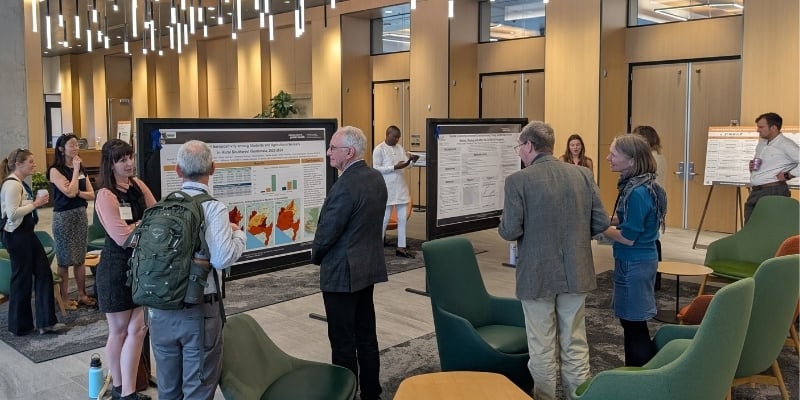Climate change is impacting our food chain, and the workers who grow, harvest, and package that food. Global temperatures increases affect the health of workers in the agricultural industry.
Researchers from the Center for Health, Work & Environment (CHWE) at the Colorado School of Public Health (ColoradoSPH) have completed their first round of data collection for a two-year heat-related research project with agricultural workers in Jalisco, Mexico, as the implementing partner ofthe International Labour Organization (ILO)'s Vision Zero Fund. The seasoned team of experts from CHWE are working to improve workers’ occupational safety and health in selected supply chains in Mexico.
The study is a collective action approach to understanding and preventing heat-associated impacts of agricultural worker health and safety in Jalisco. This research partnership with the Instituto Mexicano de Seguro Social (IMSS) is led by Principal Investigator (PI) Lee Newman, MD, MA, distinguished professor at the University of Colorado and director for the Center for Health, Work & Environment.
The produce is grown in greenhouses the size of soccer fields. Workers traverse ladders with caution as to not touch the produce with any bare part of their bodies. Temperatures in the greenhouses can reach 100.58 degrees Fahrenheit with 94.3% humidity./chwe-newsroom/11c00d63e7302864d9a5bfff0a001ce385.jpg?sfvrsn=f2507bb_0&MaxWidth=1000&MaxHeight=&ScaleUp=false&Quality=High&Method=ResizeFitToAreaArguments&Signature=AAA81C4A5A5649A4172EBF346192C521055155D1)
This study explores the same set of workers over two years, comparing the heat impacts on those harvesting versus packaging the produce. The research team is gathering multiple time points different seasons. They are measuring heat exposure, physical activity, heat-mitigation practices, and health status. After data collection, the team will collaborate with study participants to develop an intervention (workers, managers, owners, other stakeholders) in spirit of collective action.
/chwe-newsroom/12.jpg?sfvrsn=302607bb_0&MaxWidth=1000&MaxHeight=&ScaleUp=false&Quality=High&Method=ResizeFitToAreaArguments&Signature=DA9FCD103B714C5BDB091AFD9FB46AD47CFB8B34)
Using the Wet Bulb Globe Temperature measure, probes asses the overall heat impact by measuring temperature, humidity and radiation. In addition, ambient temperature humidity is measured by iButtons, worn on the outside of worker's attire. /chwe-newsroom/tests.jpg?sfvrsn=a3607bb_0&MaxWidth=1000&MaxHeight=&ScaleUp=false&Quality=High&Method=ResizeFitToAreaArguments&Signature=B3FE7F3D229135AD39EA8F9AAEF50EA8828545C5)
Along with collecting employee biomarkers before and after work, the researchers are also exploring work intensity using the Frimat and Chamous ergonomic method. Collecting multiple points of measurement contributes to a holistic assesment of how workers are impacted by heat through their daily work, demonstrating a Total Worker Health® approach to research and interventions.
/chwe-newsroom/surveys.jpg?sfvrsn=e43807bb_0)
Through surveys, participants are providing information on their own understanding and perceptions of heat impacts to their health and mitigation efforts. At the end of the workday, the team selected a few workers to take an National Institutes of Health (NIH) cognitive test that measures thinking, knowing, remembering, judging, and problem-solving. Pictured here are researching administering surveys in the employee gathering area.
/chwe-newsroom/vitals.jpg?sfvrsn=ca3707bb_0&MaxWidth=1000&MaxHeight=&ScaleUp=false&Quality=High&Method=ResizeFitToAreaArguments&Signature=59E93B08CC582F9B69740978F1B7BC443771A5E6)
In year two, the team will implement the intervention and repeat data collection of the same measures to assess how effective the intervention is on improving the health of workers. As part of the study, participants receive clinical information about their health including results of blood and urine tests to detect common health conditions like diabetes, kidney disease, hypertension, and anemia.
Stay tuned for more study updates. Our newsletter is the best way to hear about what we are doing!
/chwe-newsroom/jalisco.jpg?sfvrsn=5a1606bb_0)






